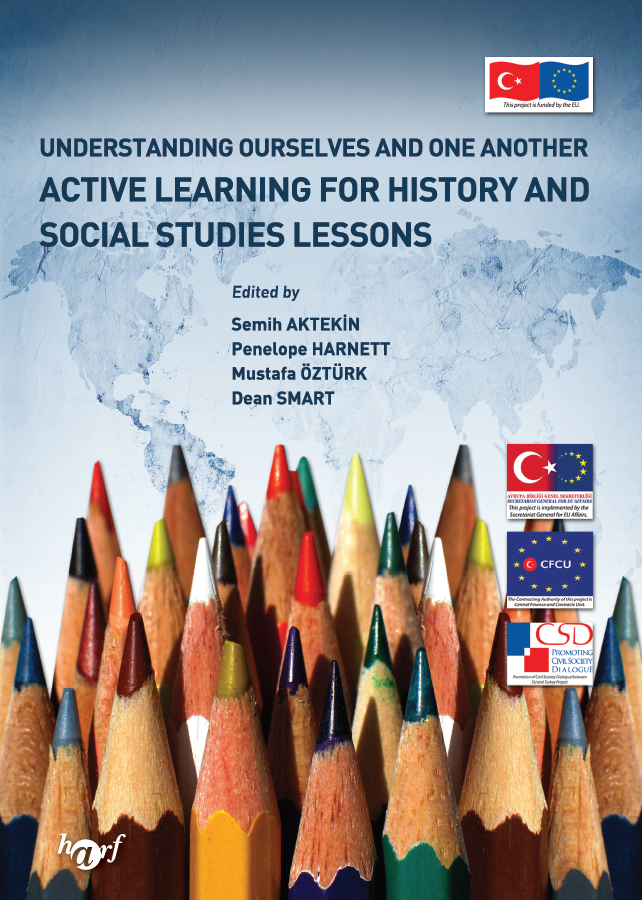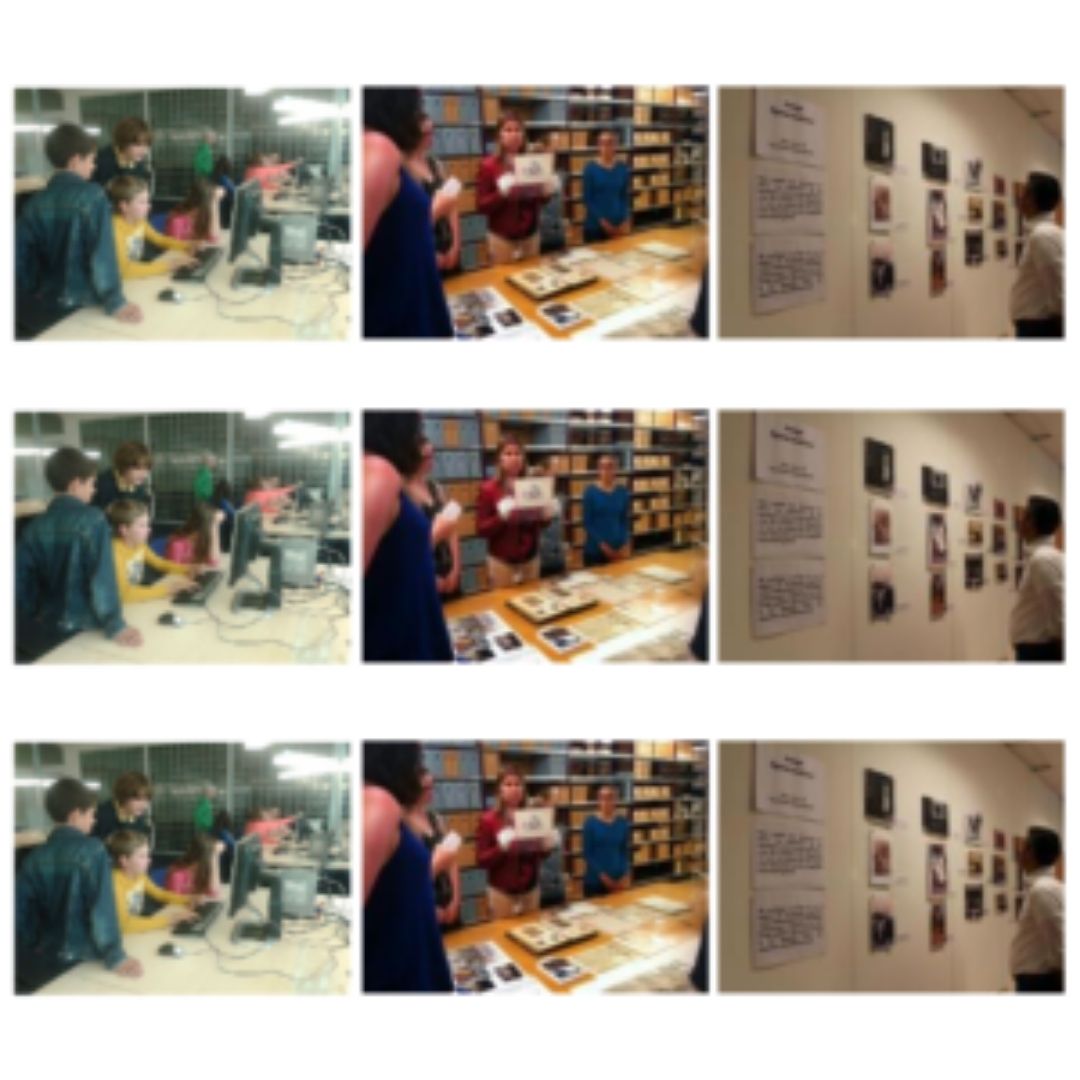In her Citizenship lessons, Fatma Afiyon initiates interactive class discussions with her students, supported by a lot of visual material, in which she addresses both historical and contemporary topics. In these discussions, the students are encouraged to view things from different perspectives and learn to form and support their opinions based on arguments. The aim of this practice is to address the fact that students have difficulties in forming and expressing their opinion, especially in a nuanced way, on relevant historical or contemporary issues.
The Practice
As teacher of the subject Citizenship, which overall prepares students for their life as citizens in society, Fatma Afiyon initiated a method that combines a lot of visual source material with interactive class discussions. This practice is used in most of the lessons, usually halfway or towards the end of a lesson, as an interactive way to discuss historical as well as contemporary issues. The duration varies from 5 minutes up to the entire lesson of 45 minutes, depending on the topic that is discussed.
The practice aims to teach students how to form and express their opinion on relevant historical and contemporary issues, including difficult topics, in a nuanced way and based on arguments. It moreover aims to help the students understand such historical and current events, periods, and issues.
To start a class discussion, a lot of visual material is shown to the students, usually through a PowerPoint presentation. This way, the students can more easily understand what a discussion is about, and form a visual image of a certain topic or event in their minds. The class discussion is often based on the question of what is going on in society. The teacher can first ask the students what they think is going on, what they find striking at the moment, or refer to visual sources on the PowerPoint.
The teacher then asks questions or asks for the students’ opinions, followed by many thought-provoking questions that encourage the students to view things from different perspectives, such as “What if I have a different opinion on this?” or “What made you think this way?”. The teacher also asks the students to support their opinions by arguments. This way, the discussion becomes interactive, and the students can learn both to discuss in a nuanced way based on arguments, and view things from different perspectives. The class discussion can be continuously accompanied by a PowerPoint presentation that the teacher made, with for example photos that were taken by themselves or found on the internet.
The topic of the discussion can be historical or contemporary, but the discussion often connects the two. Linking a historical topic to a current one also makes it easier for the students to grasp the historical topic. Making a comparison between a historical French king and the current Dutch king was mentioned as an example. The teacher can in this case ask what the difference is between the two, and if students think one is better than the other, and why. Also, the method of class discussions has been successfully used to address difficult topics like the contemporary political situation in Turkey, or, when discussing ancient Greece, homosexuality.
As a part of this method, the teacher can also assign roles to students to let them experience how it is to be in a certain position and let them discuss from this point of view. An example is assigning students the roles of historical figures, which makes them aware of the different roles that existed, and how they related to each other. A certain historical or current situation can also be applied to the situation in the classroom, which brings the situation close to the students and makes it more personal and understandable.
To provide for such a class discussion, the most important things a teacher needs are a lot of source material, and “safe space” in which the students are able to talk about any topic or issue – no difficult topics should be avoided. The teacher should make clear that all students are encouraged to express their opinion, but always in a respectful and nuanced manner. There should be clear boundaries regarding this; if a student is not respectful, they can for example be temporarily excluded from the discussion and be set aside. Here it is important to make clear why the student is excluded: not because the opinion was wrong, but because it was expressed in a wrong way. This way, the student becomes aware of how they state their opinion. By providing clearly structured lessons and being very consistent, especially in the aim of being respectful towards others’ opinions, teachers can create such a safe environment for discussion.
In terms of support material, the PowerPoint presentations are an important part. These are used in almost each lesson to provide visual sources. Other support materials that can generally be used to help facilitate or complement a class discussion are photos or videos on the internet, newsreels, and educational television programmes specifically for children and young people. Using these visual materials, instead of the standard textbook, helps students to understand and create an image of what is going on in the world, which helps facilitate and encourages the class discussion.
Obstacles and lessons learned
In this practice, it can be difficult to discuss certain sensitive topics, especially topics that students are dealing with themselves. However, it is important to not avoid any difficult topic; students should be able to openly discuss everything, as long as everyone’s opinion is respected. This should be the number one rule in the class discussions, and a teacher should have clear boundaries and consequences regarding this.
Another challenge for a teacher can be remaining neutral in class discussions, while at the same time making sure the boundaries are respected. Remaining neutral can be especially challenging when students have quite radical opinions, but it is very important to also respect their opinion. In the end, respecting everyone’s opinion and simply showing that there are also other opinions and perspectives works better than trying to convince students of alternative ideas. The focus should be on the idea that all opinions are welcome, as long as they are stated respectfully.
Remaining neutral can also be difficult if students explicitly ask about the teacher’s own opinion. What a teacher can then do – if they want and if this is appropriate –, is give their own opinion on a topic, but make it very clear that they say this as an individual instead of as a teacher. To visually make this distinction, the following example was given: the teacher physically takes a step forward to indicate that they now take on a more personal role in which they can state their own opinion. If they then step back again, they are back in their role of the teacher. While it depends on the issue and context whether this is appropriate, expressing a personal opinion can help to motivate the students, as they see that the teacher is really involved in the class discussion.
The effect of the practice
While there has been no formal research done to the results of this practice, it was mentioned that the students who have used this practice can discuss in a more respectful and nuanced way, and are more aware of the impact of the words they use. Outside the classroom and particularly with other students their age, they can fall back to their old “habits” of talking and discussing, but especially inside the classroom students’ behaviour has changed quite a bit. They for example now even correct each other in class discussions regarding the way they talk, and they are generally more open to others’ opinions rather than reacting defensive. The method, which has been used for several years, has moreover been reviewed in annual reflections with the classes who used it. In these reflections, the students were very positive about the practice.
The effects of the practice were also clearly visible during a project that took place a few years ago. When different classes were asked to comment on statements about religion, it was the class that had used this practice of class discussions that was well able to state their opinion in a more nuanced way. They for example differentiated between culture and religion, and did not attribute characteristics of certain persons to an entire group. This is a clear indicator that these students had successfully learned the competences that the class discussions aimed to teach them.
About the interviewee
Fatma Afiyon has a degree in History teaching, but is able to teach different subjects. Currently she teaches Citizenship at CVO Accent Centrum Praktijkonderwijs in Rotterdam, a school for practical education, to students who have an IQ between 50 and 80. She has always wanted to become a teacher, and earned her teacher’s degree at the age of 20. She has worked at different schools with a variety of levels. She enjoys working with – especially ‘difficult’ – youth and becoming a part of their lives. Learning that these ‘difficult’ kids try to survive their daily lives and often lack a role model to guide them, she understood the impact a teacher can have on them. She loves telling stories about different times and cultures and tries to give her students a different view on the world and life itself.
Background to the project
The practice wants to address the fact that students have difficulties in forming and expressing their opinion, especially in a nuanced way, on relevant historical or contemporary issues. It wants to teach them how to argue in a nuanced way, to make them aware of the things they say and the language they use, while also teaching them to discuss and understand certain historical or contemporary events, periods and issues. The practice is currently used in a very mixed class of students around the age of 15, who all have an IQ between 50 and 80. This group includes students who have a migrant background, are on the autistic spectrum, and/or have behavioural issues. In general, this practice can be used for many different students, as it can be easily adjusted to the needs of a specific class.
Additional information
As the practice is initiated by Fatma Afiyon herself, there is no place where more information is available. Yet if you are interested in this practice, you may contact Fatma Afiyon directly via f.afiyon@cvoaccent.nl to share ideas or talk about certain topics. In general, teachers are encouraged to find their own way in using this practice, as this method works differently for each class. How this method works in practice moreover depends on whether it suits a teacher personally, and on their motivation to address (difficult) topics in such an interactive way.
Written by Suzanne Tromp (EuroClio) based on an interview by phone with Fatma Afiyon (CVO Accent Centrum Praktijkonderwijs) in The Hague and Rotterdam on 15 May 2017.

Active Learning for History and Social Studies Lessons
The book “Active Learning for History and Social Studies Lessons” [...]

Helsingor declaration

Finding the roots of your own past Making students familiar with migration history

The AVATAR method: historical empathy through imagination

“The textbook is man-made’. Using history textbooks for active learning, critical thinking and citizenship-building’





